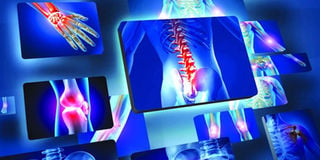Arthritis: When cold weather means more pain

Arthritis can affect any joint of the body, with the most common ones being those of the shoulder, hip, spine and knee. PHOTO | FOTOSEARCH
Imagine having to get someone to do for you even the simplest tasks, such as chopping vegetables, during the rainy season because the pain in your knuckles just won’t let you do it.
The ongoing heavy rains have worsened the misery for people with arthritis.
Ms Alice Oketch, a Kisumu resident, who has to survive on painkillers, says the pain is more intense when it rains. She gets better with the change of weather.
“This condition is incurable and I have to live with it. When it rains, I feel pain in my joints and I can’t even hold a cup of tea. I have to use a blanket all the time to keep warm,” she says, adding that her joints become stiff and she swells when it’s cold.
The word arthritis comes from two words – “arthron”, which means joint and “-itis”, to mean inflammation. Arthritis is, therefore, inflammation of joints.
It is common among the elderly, with men being at a higher risk than women. Arthritis can affect any joint of the body, with the most common ones being those of the shoulder, hip, spine and knee.
A study conducted by the University of Manchester, whose findings were released last week, showed people with arthritis are more likely to feel pain on humid and cold days than in warmer seasons. During rainy seasons the patients are more likely to be admitted for pain management than in the normal days when they tend to be well, shows the report.
LATE DIAGNOSIS
The study conducted in 2,500 people suffering from arthritis, asked them to record their levels of distress daily using their smartphones. The researchers found that those affected were 20 per cent more likely to be in pain on days that were humid and windy with low atmospheric pressure than they were on days with average weather.
However, the researchers did not explain the relationship between the condition and the weather. They hope the findings will steer future research to explain why.
One study observed that high humidity in the air damaged the aching joints. Even though it was conducted on an animal model, it provided sufficient information on the destruction of cartilage (connective joints between bones, such as the elbows, knees and ankles) and bone cells during the cold weather.
Prof George Oyoo, a consultant physician and rheumatologist at the Nairobi Arthritis Clinic, says arthritis is a condition linked to an individual’s genes and has more than 100 causes. It is easier to treat if diagnosed in good time.
“It is unfortunate that if your parents have it, the chances of you getting it compared to the general population is 10 per cent higher. In the case of twins, if one has it, then chances of the other getting it are 25 per cent higher,” he says.
However, he says, there are known cases of people without any family history of the disease getting it including those overweight, who have joint malformation, or engage in activities that stress the joints. “With a late diagnosis, it can be fatal. It gets worse and becomes difficult to manage in old age if not treated. Arthritis is just a name that covers more than 200 medical conditions that affect the joints,” he says.
BONE EROSION
Prof Oyoo clarifies that it affects people of all ages, and not just the elderly, as widely believed though different types of arthritis affect people of different ages and sexes.
For instance, he says, osteoarthritis (joint disease) is common among the elderly and affects the cartilage. Osteoarthritis causes swelling of the bones and people feel pain during the movement of the joint. It can also occur due to some injury or accident.
Rheumatoid arthritis attacks the immune system and kills its cells by causing erosion of bones.
Gout is when uric acid is deposited in between the joints. It can spread from one joint to other parts of the body. This leads to the person being unable to even move. “Different types of arthritis have different treatment, but only if one gets treatment on time,” he says.
But what can be done to relieve the patients of the pain during the rainy and humid weather? “The only way they can reduce the pain is to properly cover joints with warm clothes,” says Prof Oyoo, adding that this prevents the body from losing the heat.
He says if it's cold and one is wearing warm clothes but still feels pain, they should consider using heat packs.
Better lifestyle habits by losing weight, drinking a lot of water and consuming nutrients-rich diet can also ease the symptoms. “Dehydration of the muscles irritates them. When the weight is not felt on the joints, there is no way the joints will impair,” he says.
Engaging in regular physical activity and massaging of the affected areas helps to improve the blood flow. “If the pain persists, one needs to consult a doctor on medication and therapy,” he says.



